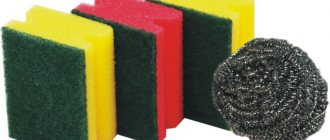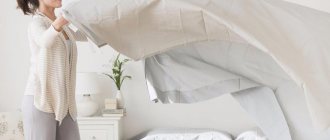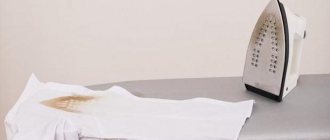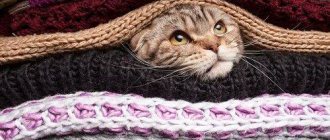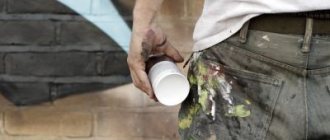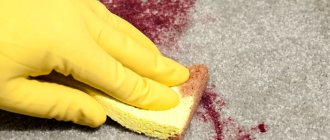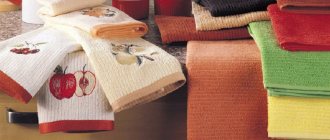How to get rid of pills on bed linen?
Pills on bed linen, or “pili” as they are also called, are far from the most pleasant thing, you must admit. They can arise for many reasons. But getting rid of them is not at all easy: they not only spoil the appearance of the product, but also create unpleasant discomfort when using the linen for its intended purpose. This problem is especially relevant for those with sensitive skin, as well as for children.
Clean a sofa at home with your own hands: professional opinion
Our favorite sofas... How many times have we spilled coffee on them through carelessness, getting dirty, leaving stains, crumbs and other contaminants.
What about children and pets? They do not stand on ceremony with upholstered furniture at all and do not even think about how to clean the upholstery later! We won’t bore you with the fact that you should only eat in the kitchen (and many people have a soft corner right next to the dining table!), that animals have no place on the sofa, or recommend buying blankets, protective covers or gray furniture. We will simply tell and show you why you should not try to remove stains on upholstered furniture yourself, since the consequences of self-cleaning can aggravate the situation so much that even professional cleaning will not be able to help you achieve the desired result.
Pills on bed linen: reasons
As a rule, pills on sheets and other elements of bed linen appear due to the fact that the fabric used in production is a priori of poor quality.
But, however, it is not only the manufacturers who are always to blame for the formation of pills on the sheets. The human factor also plays a big role in this. If you do not properly care for the material, you can cause this problem to occur. Each set of linen is accompanied by recommendations from the manufacturers on how to care for the product. You need to follow them to prevent problems that may be caused by deterioration of the product.
Another life-saving measure
You can save furniture with olive oil
Buy olive oil and apply it to the scratches. Cover these areas with a cotton cloth and wait until the oil is absorbed. You will need to cover the structure with a cloth and use a lukewarm iron. The device should be kept on the fabric for no more than ten seconds.
There is one caveat to this method of saving a sofa from cat scratches: you can’t just take the iron and place it on the fabric. This will ruin the leather upholstery of your furniture. You should move the device in a circular motion over the fabric until the oil is completely absorbed.
How to get rid of pills on bed linen?
The best minds of humanity have come up with a whole host of means with which you can remove pills from bed linen.
Machines for removing pellets
One of the most modern and convenient methods of getting rid of pellets. With the help of such a device, you can quickly and easily bring your bed linen into a “divine look.” The machine cuts off the pellets and sends them to a special compartment, and the procedure does not take much time and does not require much effort. 5 minutes - and you have recreated the original look of bed linen.
Razor or blade
This method, of course, is inferior in efficiency and speed to machines for removing pellets, but it still has a place, since a razor can be found in absolutely any home. The main disadvantage of this method is the likelihood of cutting the fabric by hitting it with the sharp end of the blade. Another inconvenience is the need to independently remove the cut pellets from the surface of the material.
Scotch
You will obviously have to work hard with this method, since its effectiveness is quite low. The adhesive side of the tape is glued to the “rolled” surface, and then peeled off with a sharp movement of the hand. This method is more suitable for bed linen that has just begun to form pills. You can also work using a similar principle with adhesive tape, which is sold in rolls and is intended for cleaning clothes.
Nail scissors
If the pellets on the bed linen are concentrated in one area and are quite large in size, then you can cut them off using nail scissors. In this case, you should act extremely carefully so as not to damage the surface of the fabric or cut the material. Of course, this method is quite labor-intensive and is suitable either for working in a small area or as an auxiliary method.
Pumice
This method also works; pumice stone is ideal for bed linen. It can carefully and carefully release fabric fibers from rolled-up particles without damaging its surface. Using the same principle, sandpaper of varying abrasiveness is used for coarser fabrics.
How to remove with a removal machine?
A specially designed machine will help you quickly and effectively get rid of traces of rolling on your favorite things.
The device is equipped with:
- a fan for sucking pellets into the grill;
- stainless steel blades for removing them from the surface of the fabric;
- container in which cut particles are collected.
Mode of application:
- Insert batteries.
- Enable using button.
- Work the surface of the product in a circular motion.
For knitwear with pile, you need a device with the ability to adjust the height of the blade. A review of pellet removal machines is presented in this article.
How to choose bed linen that will not form pili?
First, remember that preventing the formation of pills on bed linen is much easier than dealing with the consequences. If you have purchased high-quality products, then with proper care you create a guarantee of protection from this scourge.
If you have already purchased a set of bed linen, cared for it correctly, but stains still formed, then this is direct evidence that you made a mistake in your choice. So, what should you pay attention to when buying bed linen in order to avoid unpleasant consequences?
In short, never skimp on bedding. It must be of excellent quality, from a good manufacturer and, best of all, made from natural material. Materials least susceptible to pili formation are linen, silk and cotton.
If your bed linen is “rolled up”, do not despair, it is better to be patient, arm yourself with auxiliary means and go ahead! Do not rush to throw away such products, because with proper handling they will serve you for at least another couple of years.
463 Author of the article: Natalia Nadsadina Reading time: 4 min.
You can clean laundry from pellets that form on the fabric at home using the methods below.
How to clean the matting on the sofa correctly?
Matting, like sofa upholstery, does not require complex care. It can be cleaned 1-2 times a month with a vacuum cleaner to collect crumbs, dust and other small debris. Once a year, it is recommended to order sofa cleaning at home, with which you can remove any types of stains, unpleasant odors and greasy conditions. If you want to clean the furniture yourself, then remember that the following methods are not recommended for cleaning this type of upholstery:
- household stain removers without prior testing on a small area of fabric. Remember that some household compositions, which distinguishes them from professional ones, can cause the material to fade;
- Do not use bleaches or abrasive powders that destroy the structure of the upholstery;
- vegetable oil, vinegar, hydrogen peroxide and other aggressive folk remedies. When using them, be prepared for the area of upholstery to be cleaned to fade, the surface may become covered with sloppy pellets, so it will look worn out;
- If you purchased covers made from the material in question, then after washing, do not twist them or dry them on heating devices. The best solution is natural drying on the balcony. The water temperature during washing should not be more than 30-40 C, but here everything depends on the manufacturer’s recommendations and the exact composition of the fabric.
Methods
Machine for cleaning products from pellets
Online stores offer a wide selection of machines for eliminating lumps that have appeared. The cost of the devices is affordable, it is no more expensive than a regular clothes brush. Pros: battery operated; The charge is enough to clean several things; compactness of the machine. There are a number of large machines that operate on mains or battery power.
Well-known models from different manufacturers:
Standard equipment of the device: grille with a protective cover; device body equipped with a blade; container for collecting cut lint.
The machine (depending on the model and manufacturer) most often has one or several operating modes (for example, separate adjustment of the nozzle for delicate materials).
Important! Saw clippers are not suitable for fabrics with fluff and high pile. The lint gets wrapped around the screw of the device, making it difficult to operate. And material with large loops clings to the blades, especially if a person works carelessly with the device or presses too hard on the machine.
Pros: efficient, fast and high-quality cutting of pellets and subsequent assembly into a special compartment.
Disadvantages : the procedure for removing pellets when the batteries (battery) are dead becomes slower; Not recommended for high pile materials.
Blade or razor as an effective method
A razor can easily handle “coughed” areas, but a sharp blade can damage fabric (especially delicate ones) by cutting through or snagging the delicate material. And when using a dull blade, the pellets are almost impossible to cut off, but it is easy to leave marks and abrasions from the touch of the machine on the material. Recommended for removing pellets from bedding made from a mixture of synthetics and chintz.
Pros: high efficiency, quick results.
Disadvantages: it is easy to spoil the item; the pile has to be collected after cutting.
Method for removing pellets using sandpaper and pumice
Treatment with pumice or sandpaper is based on rubbing the threads that hold the lumps. It’s enough just to stretch the fabric, walk over it with one of the products and just brush off the pellets, they will easily come off.
Important! It should be taken into account that the thinner and more delicate the material, the finer the abrasive is taken. For dense, hard products, sandpaper is recommended, and for knitwear, pumice.
Pros: quick results
Cons: Not recommended for delicate materials.
Scotch tape, adhesive roller
Treatment with adhesive tape from the side resembles waxing: we stick the strip with the adhesive side, smooth it and sharply tear it off. It is better to apply where the pili are just beginning to form.
Pros: does not damage the fabric.
Disadvantages: the method does not always cope with lumps; effectiveness depends on the stickiness of the tape.
Another method is a sticky roller for cleaning clothes. Its surface is more sticky than tape.
Pros: copes well with “rolled” areas.
Cons: not recommended for processing thin and delicate materials, high pile.
What not to do?
Not all methods are effective and universal for different fabrics. Not recommended:
- Cutting rolled fibers from very thin material will cause damage.
- Remove pellets with abrasive materials from products subject to deformation.
- Remove damaged areas from hosiery with a toothbrush; it will roll the fibers over the surface and ruin the item.
- Use stationery tape and a sticky roller for fabrics with long pile.
- Plucking the pellets with tweezers or your hands can pull the thread out of the fabric to the surface and aggravate the problem.
Before you begin, you need to determine which cleaning method is suitable for this material.
Reasons why pills form on bed linen
There are several reasons for the formation of saws on bed linen, depending on the manufacturer: the presence of synthetic fiber in the fabric, a violation of the manufacturing process (weak twist of the thread, exceeding the drawing norm, decreased fabric density).
Important! The consumer is advised to choose natural fabrics, follow product care recommendations, and buy underwear from trusted manufacturers.
But not everything depends on the company manufacturing the material. Mistakes in caring for things made by the owner also lead to their destruction. This is washing satin, cotton in too hot water; refusal of air conditioner, which helps maintain the elasticity of the product; ironing dry bed linen. In addition, too frequent washing and mechanical friction against a person during restless sleep also leads to the material rolling up.
On what bedding materials do pills appear?
Lumps appear on fabrics that contain synthetics. The base material is wound onto such a thread, and during use the fabric simply fluffs up and pellets appear. More susceptible to rolling: woolen products, acrylic, knitwear, polyamide, fleece, polyester.
Attention! How to recognize fabric that is likely to have pilling? The labeling indicates a high content of synthetic fibers, the material is loose, the threads are long, and the pile is high. Natural materials (cotton, silk, linen) are less likely to cough.
Why do coils appear on clothes?
The appearance of small balls of loose threads is not always an indicator of worn-out clothing. A new item may also develop pills after the first wash. Sometimes the reason for this is an incorrectly selected automatic machine program or unsuitable powder. Knowing why the material begins to cough, you can prevent this in advance or delay the appearance of small balls.
Pilling on clothes can occur due to improper care
The main reasons for the formation of pellets on fabric are:
- composition of the material from which the product is made. Items made from natural fabrics are less resistant to lumps. If you often wear a wool sweater or linen trousers, they will wear out faster than, for example, synthetic products, which even wrinkle much less;
- incorrectly selected washing mode. To maintain the original appearance of the product, after purchase you should carefully examine the labels on the clothing. The manufacturer indicates on them important information about how to properly care for the item, how to wash, iron, and whether spinning in the machine is allowed. Even the most expensive things quickly lose their appearance due to improper care;
- wrong choice of detergent. Modern powders intended for delicate items contain special substances that prevent threads from rolling. Thanks to a more gentle effect on the material, clothes remain looking new for a longer time;
- loosely twisted threads. On items made from tightly twisted threads, lumps appear much later than on items made from loosely twisted threads;
- constant friction against the material. The armpit area of clothing is constantly exposed to friction from a bag, backpack, or the clothing itself. Since such places wear out faster, balls appear here first.
Following the rules of delicate laundry washing as a way to prevent lumps
Why does delicate washing reduce the likelihood of pilling? The mode is based on reducing the spin force of the laundry, and washing occurs with an increase in the volume of water in the drum, which reduces friction of the material. Delicate washing takes place at a temperature of 40 degrees , which reduces the likelihood of fabric shedding. There is no drying option in the washing machine.
Some models do not have the name “delicate wash”, it is replaced by the synonym “hand wash” .
What materials are washed this way? Washing in “delicate conditions” is ideal for artificial fabrics (polyester, elastane, viscose) and natural ones (silk, wool).
Important! Before washing, you should carefully study the label of the bed linen, which states the composition, washing and ironing mode.
For this mode, choose liquid detergents , which are easier to wash out of the fabric.
Upholstery restoration
Before you begin repairs, you need to assess the type of damage, the extent and equip yourself with the necessary repair kit. Remember that the method of restoring upholstery directly depends on the type of fabric.
Repair of natural and artificial leather
A considerable number of special products have been developed to eliminate damage to leather upholstery. One of the most popular of them is considered to be “liquid skin”. This is a special solution that has the consistency of a paste. Choose the right color and follow a few simple steps:
- Soak a cotton swab in alcohol and degrease the desired area where the skin is torn.
- Place the "liquid skin" into the hole.
- Use a clean cloth to press the area with the paste applied.
- Use the iron (2-3 seconds).
The paste completely fills the hole and melts at high temperature. If the color of the “liquid leather” is chosen perfectly, there will be no trace of a hole in the upholstery - the surface will look solid.
In order to repair damage in the form of a broken seam, you do not have to be a furniture maker. You will need threads in the color of the old stitch, a needle whose diameter does not exceed the existing holes from the factory machine, and an assistant. One person should use their hands to tighten the loose edges as much as possible, and the second person should sew the stitching using factory punctures. Having reached undamaged stitches, you need, for greater reliability, to walk along them two or three steps.
How to fix fabric upholstery
If a hole appears on a fabric surface, a patch is an excellent way to fix it. Its color can be chosen to match the sofa or made contrasting, combining repairs with updating the boring type of furniture. The main thing is that the new design does not contradict the overall design style of the house. Before sewing on the patches, you need to process the fabric - remove spools and protruding threads. Then cut out a piece of material of the required size, secure with basting, smooth with an iron and carefully sew on it. For these purposes, it is better to purchase a special rounded furniture needle.
Washing with foil to prevent pilling
A couple of thick balls of foil placed in the drum during washing will help remove the static charge of electricity during the washing process. This reduces the attraction of dust and microparticles to the material.
In addition, mechanically knocking out dirt with foil balls will reduce the required amount of detergent and improve the removal of dirt and stains. Bed linen can be washed less often, using more gentle modes, without losing the quality of the wash, and there will be fewer pills.
Based on this, we can conclude that getting rid of pellets at home is not difficult, but you need to choose the right method of action so as not to spoil the thing and get results.
For example, a razor is not suitable for silk and other delicate fabrics ; there is a high probability of ruining the item. And from exposure to tape, the treated area will stretch and lose its shape.
Advice: a universal way to eliminate pellets will be a high-quality machine for cleaning pellets.
Remember that it is much easier to prevent the appearance of lumps by carefully caring for the item, washing it on a gentle cycle or buying bedding made from natural fabrics from trusted manufacturers.
How to avoid pili
To make clothes and other products last longer and not become covered with pills, use simple tips:
- reduce to a minimum the contact of tissues prone to the appearance of saws with surfaces that can touch them;
- wash items strictly according to the instructions, using detergents for manual or delicate machine processing;
- When rinsing the product, add a special conditioner;
- Don't wring things out when it comes to spinning to keep the pile soft and smooth.
Video: washing with foil to prevent pilling
Ways to get rid of pellets
You can use a machine to remove pills from clothes; there are also other methods. Some methods are not suitable for all types of fabrics.
Special device
The machine allows you to adjust the distance of the knife so as not to spoil the decorative elements of the product. This is the fastest, safest way to remove pellets. The device is inexpensive - 300-400 rubles.
If the device version does not allow for adjusting the length of the knives, it cannot be used on long-pile fabrics.
Razor
This quick method is not suitable for delicate, fleecy, thin materials. A razor is used to remove pellets from woolen items without relief. You need to stretch and fix the thing on a horizontal, flat surface. The razor is drawn from top to bottom, then from right to left, or vice versa.
For socks, mittens, tights, this method is suitable: put on the item, shave off the pills on yourself. The razor is not suitable if the fabric is expensive or delicate. If there are puffs, the blade forms a hole in this place.
You can use a blade that is inserted into the razor. It is taken separately and carefully passed along the fibers.
A disposable machine without a soap strip is ideal. It is sharp enough and will not damage your clothes with this strip.
Toothbrush
You will need a brush with soft bristles. Act along the fibers, scratching until the pellets go away. In this way they are removed from angora, mohair, and cashmere sweaters. To give it its former fluffiness, rinse the item in a solution of vinegar and water. Dry flat, away from the sun and heating elements.
Nail scissors
A long, monotonous method for diligent people. Each pellet is cut separately. Suitable for getting rid of pellets from pants or other small surfaces. If you handle scissors carelessly, the item can be hopelessly damaged.
To simplify the work, first comb the product with a comb with small teeth. To restore the hairiness of the material, after cutting, the clothes are treated with a soft suede brush.
Sticky roller, tape
These devices can remove pills from a T-shirt or a dress - from any thing. Suitable for recent, soft, small pellets. Scotch tape acts like wax strips:
It’s easier to work with a roller: you simply roll it over the surface of your trousers or jacket. To make such a video with your own hands, just fix the tape on a plastic bottle. Large old large pellets cannot be removed using this method.
Sandpaper, crackers
How to get rid of pellets: rub the problem area with sandpaper. Only fine-grain paper can be used.
Instead of sandpaper, a simple cracker will do. You need to cut a thicker piece of bread and dry it in the oven (or in the sun) on a clean baking sheet without oil. They rub the desired area like sandpaper.
These improvised means are used to remove pellets on smooth, lint-free materials, otherwise the clothes will be ruined forever.
In addition to sandpaper or crackers, they use pumice. It is less rough and suitable for delicate fabrics.
Rough sponge, dish sponge
You will need the back of a dish sponge or a stiff washcloth. Wipe the product along the fibers of the fabric so as not to spoil the item. Suitable for use at home if there are few pellets, they are soft and small. It is recommended to use a new dry washcloth.
Dry cleaning
An ideal option when you have money but no time. Professionals will do all the work quickly, without problems. In addition to getting rid of pellets, the product will be treated with a prophylactic agent. This includes outerwear, expensive woolen items: angora, mohair, cashmere, alpaca.
It is better not to try to remove pills from a cashmere coat or angora blouse yourself. You shouldn’t run to the dry cleaner with a sheet or T-shirt, but you don’t mind spending money on cleaning an expensive item.
other methods
How to get rid of pellets:
These methods will help if you pay attention to the appearance of pellets in time.
How to care for furniture with matting upholstery
Textiles can be cleaned using dry and wet methods. Both are suitable for matting. Invite the specialists of the company CLEAN EVERYTHING. They will get your upholstery in order quickly and inexpensively. But, if you decide to clean the matting sofa yourself, use the advice of our experts.
Dry cleaning a matting sofa
By home dry cleaning we mean brushing or dusting with a regular vacuum cleaner. Use the special nozzle from the complex. Go over the entire surface of the textiles, inspect the upholstery to see if there are any stains on it. If it is clean, then a simple vacuum cleaner with good power is enough to remove a good half of the accumulated dirt and dust from the textile.
If the furniture has been in use for a long time, it may be time to give the sofa a deep cleaning. You can use:
- Active foam Vanish for textiles and carpets;
- Powder for dry cleaning of upholstered furniture, which will remove dirt from deep within the fibers and eliminate unpleasant odors;
- Products for cleaning car seats;
- Professional dry cleaning of furniture from the company CLEAN EVERYTHING.
Do not use hard brushes to care for the matting. They leave marks on textiles.
Water cleaning of a sofa made of matting
Aqueous solutions of laundry soap and textile shampoo are used to remove stains and deep clean. After treating the fabric with solutions or foam, it must be thoroughly dried, preferably naturally. In the wet season, you will need a hairdryer for this.
Wet cleaning of a sofa with matting upholstery can be:
- Manual (applying foam with a sponge, spraying the finished product from a package with a dispenser) and machine (washing vacuum cleaner);
- Amateur (with your own hands) and professional - with a call from specialists from a specialized company;
- Standard and environmentally friendly - products based on plant-based, environmentally friendly components.
Detergent solutions penetrate too deeply into upholstered furniture and take a long time to dry, which creates conditions for the development of mold and mildew. It is better to use foam, steam from a steam generator, or a moistened microfiber cloth.
Removing stains
By letting the stain dry, you are making your job more difficult. It is easier and more effective to remove it using fresh traces:
- Thoroughly blot any stain with paper towels from top to bottom, without rubbing it on the sofa, without increasing the area of damage;
- If you have Vanish stain remover spray, use it. Follow the manufacturer's instructions on the packaging;
- 10 ml of ammonia per 1 liter of water is a good cleaner for juice and fruit stains. After removing the stain, the remaining solution is carefully removed with a damp cloth;
- Laundry soap will help remove traces of wine, coffee, tea, and dark berries. The foam from it is applied to the stain for a quarter of an hour, then wiped with a damp cloth and dried with a paper towel;
- Wine stains are sprinkled with table salt and then wiped with clean cold water;
- Blot fresh blood with a cotton pad soaked in a hydrogen peroxide solution. Change discs more often so as not to smear a large surface with them;
- Use acetone or an aqueous solution of alcohol (1 tablespoon per 1 liter of water) to remove stains from a felt-tip pen or marker.
Problems with bed linen
The reasons for the appearance of pellets remain the same. Proper care is necessary to prevent occurrence. The pills on bed linen cannot be removed with scissors or tape. This will take too much time. What to do in this case:
It is necessary to choose quality bedding. Products from Turkey, Russia, Europe, Hong Kong are recommended.
